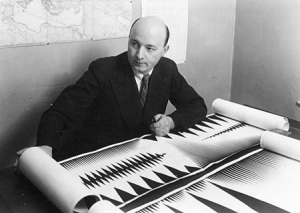Gallery
All Pictures (2)Biography
Oskar Fischinger was born in Gelnhausen on June 22, 1900. He initially aspired to a career in music, learned to play the violin as a student, and began an apprenticeship with an organ builder who was later drafted into World War I. Fischinger then began a new apprenticeship as a draftsman with the city architect of Gelnhausen. In 1916, he moved to Frankfurt and continued his apprenticeship at a turbine factory, where he graduated as a mechanical engineer. In August 1922, Fischinger received his diploma as an engineer.
In 1921, Fischinger attended the world premiere of Walther Ruttmann's abstract animated film "Lichtspiel Opus I" in Frankfurt, which sparked his interest in abstract or absolute film. He was introduced to Ruttmann by Dr. Bernhard Diebold. Fischinger and Ruttmann continued to correspond, and in November 1922 they signed a license agreement for a wax-cutting machine for animated films that Fischinger had developed. This machine made it possible to create fluid sequences of images by cutting thin slices from a block of wax and recording them frame by frame. Fischinger also experimented with other animation techniques, including abstract three-dimensional wax figures, swirling colored liquids, and abstract diagrams.
Fischinger moved to Munich to devote himself entirely to filmmaking. He created his own abstract works using various animation techniques and worked as an animator on several traditional cartoon films by Louis Seel using rotoscope technology. He also presented some of his films at "ColorLightMusic" events organized by composer Alexander Lászlo, which combined concerts with light shows and multiple projections.
When Louis Seel & Co. ran into financial difficulties, Fischinger was forced to leave Munich in June 1927. He wandered to Berlin, where he initially had difficulty finding work. In July 1928, he was hired by Ufa to create special effects for Fritz Lang's groundbreaking science fiction film "Frau im Mond" ("Woman in the Moon"). The following year, he broke his leg on the Ufa lot, which he interpreted as a sign to focus exclusively on his abstract film work. Over the next three years, he produced a series of black-and-white "studies" meticulously synchronized to music. These were so successful that by 1932 Fischinger was able to employ his brother Hans, his wife Elfriede, and three other women in his studio.
In the period that followed, Fischinger devoted himself to experiments with drawn, synthetic sound and collaborated with Bela Gaspar on the development of a subtractive three-color film process called "Gasparcolor". As the Nazis consolidated power from 1933 on, the abstract film and art communities, along with their distribution channels, quickly disappeared due to the Nazis' policy of targeting what they called "degenerate art." In 1934, Fischinger presented his first color film using the Gasparcolor process, "Kreise". His subsequent color films "Muratti greift ein" and "Komposition in Blau" were so well received by critics and audiences that Fischinger was offered a contract by Paramount. In February 1936 he emigrated to the USA and went to Hollywood.
However, his attempts to work for the major studios failed due to Fischinger's language difficulties and his often uncompromising attitude. His engagements with Paramount (1936), MGM (1937), where he made the film "An Optical Poem" to Liszt's "Hungarian Rhapsody No. 2", and Disney (1938-39), where he worked on the visualization of Bach's "Toccata and Fugue" for "Fantasia" but left due to excessive studio interference, were all short-lived. His later (1941-42) collaboration on one of Orson Welles' many abandoned projects was also brief.
Hilla Rebay, curator of the Solomon Guggenheim Foundation, supported Fischinger with several grants during the difficult war years. However, due to disagreements over the artistic value of his film "Motion Painting No. 1. (1947) to Bach's Brandenburg Concerto No. 3, Rebay and Fischinger fell out. After that, he did not receive sufficient support from her or other sources, so he was unable to complete any more personal film projects, and only managed to produce a few commercials in the 1950s. Previously, out of frustration at not being able to make films independently, he had increasingly turned to oil painting.
Fischinger remained immensely productive, and his paintings were shown in numerous exhibitions, but many other artistic and film projects remained unrealized or unfinished. In the late 1940s, he designed the Lumigraph, a sophisticated light show device for home use, which was used in some performances to music but brought him little financial reward.
After a long illness, Oskar Fischinger died in Hollywood on January 31, 1967.
Since then, his pioneering work in film has been honored in numerous exhibitions worldwide, most notably in the major exhibition "Oskar Fischinger (1900-1967): Experiments in Cinematic Abstraction" at the EYE Filmmuseum in Amsterdam in 2012-13.
